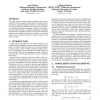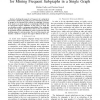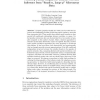920 search results - page 42 / 184 » Computing the Frequency of Partial Orders |
AAAI
2012
11 years 10 months ago
2012
We present the first real-world benchmark for sequentiallyoptimal team formation, working within the framework of a class of online football prediction games known as Fantasy Foo...
DATE
2004
IEEE
13 years 11 months ago
2004
IEEE
This paper presents a model reduction algorithm motivated by a connection between frequency domain projection methods and approximation of truncated balanced realizations. The met...
KDD
2006
ACM
14 years 8 months ago
2006
ACM
Ordering and ranking items of different types are important tasks in various applications, such as query processing and scientific data mining. A total order for the items can be ...
MLG
2007
Springer
14 years 1 months ago
2007
Springer
—Defining the support (or frequency) of a subgraph is trivial when a database of graphs is given: it is simply the number of graphs in the database that contain the subgraph. Ho...
BIRD
2008
Springer
13 years 9 months ago
2008
Springer
Abstract. Gaussian graphical models are widely used to tackle the important and challenging problem of inferring genetic regulatory networks from expression data. These models have...



